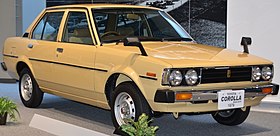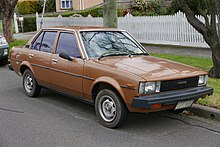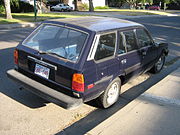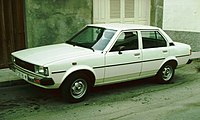What Is The Change Wheel Setting On A Toyota Corolla
| Toyota Corolla (E70) | |
|---|---|
 1979–1980 Corolla E70 Sedan | |
| Overview | |
| Manufacturer | Toyota |
| Also chosen | Daihatsu Charmant Toyota Sprinter Toyota T-18[i] |
| Production | March 1979–June 1987 |
| Assembly | Toyota City, Japan (Takaoka plant) Port Melbourne, Victoria, Commonwealth of australia (Australian Motor Industries) Thames, New Zealand (Toyota New Zealand - Thames found) Parañaque, Philippines (Delta Motors Corporation) Samut Prakan, Thailand (Toyota Motor Thailand - Samrong plant) Shah Alam, Malaysia (UMW Toyota Motor) North Jakarta, Indonesia (Toyota Astra Motor - Sunter institute) |
| Body and chassis | |
| Body way | 2-door sedan 4-door sedan 2-door hardtop coupé 3-door liftback three-door station wagon 5-door station carriage 3-door van[2] five-door van |
| Layout | FR layout |
| Powertrain | |
| Engine |
|
| Transmission |
|
| Dimensions | |
| Wheelbase | two,400 mm (94.five in) |
| Length | 4,050–4,240 mm (159.4–166.nine in) |
| Width | ane,610–1,625 mm (63.4–64.0 in) |
| Height | i,325–1,390 mm (52.2–54.7 in) |
| Curb weight | 790–975 kg (1,742–2,150 lb) |
| Chronology | |
| Predecessor | Corolla E30 |
| Successor | Corolla E80 Corolla E90 (wagon/van) |
The Corolla E70 was the fourth generation of cars sold past Toyota nether the Corolla nameplate.
The fourth-generation model was released in March 1979 in Japan,[iii] and was the last generation to have the unabridged lineup in rear-cycle-drive configuration. Consign sales commenced in Baronial 1979.[four] Although nigh of the fourth generation was replaced past 1984, the station wagon and van versions were offered into late 1987. In 1980 Corolla daily production reached an all-fourth dimension high, averaging ii,346 units. The ane-millionth Corolla was a 70-series, built in February 1983. A limited "One Million Edition" was released in Japan at this fourth dimension.[five]
Development [edit]
This generation (apart from the railroad vehicle) got a new rear whorl bound five-link rear end with a panhard rod (2 years after its primary Japanese rival the Nissan Sunny had made the same change), and the wheelbase was longer at 94.5 in (2,400 mm). A new 1.viii L (1,770 cc/108 in³) 3T engine was optional to some markets, while parts of the earth retained the old 4K. The nearly notable inline-four engine advancement came in 1983, yet, equally Toyota began offering the ane.6 L (1,587 cc/96 in³) 4A-C. The aluminum head, SOHC engine, although bulkier in size and weight than the K and T engines it was offered alongside, was a yard step up in functioning. This would be the final generation of Corollas to use any pushrod or fe cylinder head engines, equally Toyota made the decision to focus exclusively on aluminium head, OHC engine design from this signal forward. This was the start generation to take ability steering. In the U.s.a. market, this was introduced in 1981 for the 1982 model year.



Various facelifts were made during production. In 1979–1980, a four-round headlamp setup was used in almost markets. A restyle for 1981 involved two rectangular headlamps. A more than all-encompassing facelift was given for 1982, involving a new sloping nose with wraparound headlights, remodeled taillights and new bumpers, which on some models were rubber moulded. From August 1983 (subsequent to the changeover to front end-wheel drive for the balance of the range) the Corolla Van received a new 1.5-litre 5K-J engine as well every bit a low-cal restyling, and too a roof raised by 45 mm (i.viii in).[6] The Carriage/Van underwent a terminal light facelift in August 1985, including an upgraded 1C-II engine for the diesels.[7] It also received seats that could be folded nearly flat to make the car beddable, and continued in production until beingness replaced by the 90-series Corolla Van/Wagon in Baronial 1987.
Design [edit]
Design piece of work was started in 1974 past Fumio Agetsuma. The goals he told his team were:[8]
- Quiet cars will have a definite edge. Conservation of both resource and fuel will be very important. Economy and value volition also carry considerable weight.
- Our new Corolla must be equally aerodynamically perfect as the parameters allow. Information technology must exist comfortable, with plenty interior room to move about in. It will demand all the modern features that hereafter customers will want as well.
- Corolla must change. But we should never destroy the popular base upon which Corolla sales are built. Our new car must reverberate the wishes of the consumer, the ordinary people who bulldoze Corollas.
- There should be no generation gap with Corolla. It should entreatment to young and one-time alike. Corolla must also transcend national boundaries. It must perform likewise in sub-zero temperatures as information technology does in the torrid zone or in the heat of the deserts of the world. Above all, Corolla must be a car that pleases.
- Corolla has an illustrious tradition. At present, let us build our new Corolla on that tradition, the kind of new Corolla we know the drivers of the world will wait.
Japan [edit]

1982–1983 Corolla Levin series TE71 (Japan)

1982–1983 Corolla Sedan 1600 GT (TE71)
In Japan, where it was introduced in March 1979, the Corolla was offered in all body styles: 2-door Sedan, four-door Sedan, two-door Hardtop Coupé, three-door Coupé, and iii-door Liftback Coupé. The iii- or five-door Van models were added to the lineup in August 1979; until and then the old 30-series Van had connected to be available.[9] This was besides when the 1.8-litre 13T engine first became available in the domestic Japanese market.[x] The Levin continued as a coupé, with a sporting iv-door sedan chosen the Corolla GT also available.
Feb 1982 saw the introduction of the Toyota 1C diesel engine installed in the Corolla sedan.[five] This car was sectional to the Toyota Diesel fuel Store to encourage sales at the largely commercial truck retailer for Toyota in Japan, alongside the larger, diesel-engined Toyota Vista. At the same fourth dimension, the Van was no longer available with the one.half dozen-litre gasoline engine, but the v-door KE73G railroad vehicle was introduced as the get-go Corolla Wagon to be sold in Japan (rather than the "van" commercial car).[six] The Van/Wagon continued to be offered until August 1987, skipping the first front end-wheel-bulldoze generation of Corollas. After the introduction of the front-wheel drive E80-serial Corolla, the Van range received a facelift and a new ready of chassis codes (KE72V, KE74V, CE71V).
Japanese market engines:
- 4K-U — 1.3 L (1290 cc) I4, 8-valve pushrod, carb, 74 PS (54 kW) (KE70, KE73G)
- 4K-J — i.three L (1290 cc) I4, 8-valve pushrod, carb, 69 PS (51 kW) (KE71V, KE72V, van only) 72 PS (53 kW) in afterwards models[11]
- 5K-J — ane.5 L (1496 cc) I4, viii-valve pushrod, carb, (KE74V, van only)
- 3A-U — 1.5 L (one,452 cc) I4, 8-valve SOHC, carb, 80 PS (59 kW) (AE70)
- 12T-J — 1.six L (1587 cc) I4, 8-valve pushrod, carb, 86 PS (63 kW) (TE73V,[6] TE74V from Baronial 1981)
- 2T-GEU — 1.half-dozen Fifty (1587 cc) I4, 8-valve DOHC, EFI, 115 PS (85 kW) (TE71)
- 13T-U — one.8 50 (i,770 cc) I4, 8-valve pushrod, 95 PS (70 kW)[12] (TE70)
- 3T-C — ane.eight L (i,770 cc) I4, 8-valve pushrod (TE72)
- 1C – 1.8 L I4 diesel, 65 PS (48 kW)[12] (CE70, CE71V)
Northward America [edit]
The E70-series Corolla Hardtop and Liftback models were amid the last true pillarless hardtops bachelor in the United States. These models used the aforementioned 13-inch styled steel wheels and trim rings that graced the U.S-market place 1974–75 Celica GT.
North American market engines:
- 3T-C — one.eight 50 (1,770 cc) I4, 8-valve Pushrod, carb, 75 hp (56 kW)
- 4A-C — 1.6 Fifty (i,587 cc) I4, eight-valve SOHC, carb, xc hp (67 kW)
North American market place VDS:
- E71 — Sedan, 2-door/4-door (Std, DX)
- E71 — Railroad vehicle, five-door (Std, DX)
- E71 — Hardtop, 2-door (SR5)
- E71 — Coupé, 2-door (SR5)
- E71 — Liftback, 3-door (Std, SR5)
- E72 — Sedan, five-door (Std, DX)
- E72 — Wagon (Std, DLX)
- E72 — Coupé ii-door (Std, SR5)
- E72 — Liftback, iii-door (Std, SR5)
- E72 — Hardtop, two-door (Std, SR5)
- E75 — Hardtop, two-door (SR5)
- E75 — Coupé, 2-door (SR5)
- E75 — Liftback, iii-door (Std, SR5)
-

Corolla TE72 2-door sedan (U.s.a.)
-

Corolla TE72 hardtop coupe (U.s.)
-

Corolla TE72 wagon
-

Corolla SR5 fastback (pre-facelift; Canada)
Australia [edit]
The TE72 Liftback was marketed in Australia as the Toyota T-18 equally it was originally sold alongside the previous 30-series Corolla range.[13] [1] Introduced in October 1979, it was fitted with a 1.8-litre engine and a five-speed transmission and was available in either standard or Deluxe trim.[14]
seventy series sedan, wagon and panel van variants were introduced in Oct 1981 with a ane.3-litre engine.[15] Facelifted models were offered from October 1983, with a i.6-litre engine now available every bit an choice.[16] A special edition sedan called the "Corolla Spirit" arrived in early 1984; it received a boot spoiler, the 1.6-litre engine, chromed wheel trim, stripes, and some additional equipment.[17]
Australian market engines:
- 4K-C — 1.3 50 (1290 cc) I4, 8-valve Pushrod, carb, 48 kW (65 hp)
- 4A-C — i.six 50 (1587 cc) I4, 8-valve SOHC, carb, 58 kW (78 hp)
- 3T-C — 1.8 50 (1770 cc) I4, 8-valve Pushrod, carb, 56 kW (75 hp) (E72, sold as the "Toyota T-18")[1]
-

1983-1984 Corolla KE70 wagon (Australia)
-

1983-1984 Corolla Sedan KE70 CS (Australia)
Europe [edit]
Most E70-serial Corollas sold in Europe were fitted with the 1.3-litre 4K engine, producing 60 PS (44 kW).[18] All European marketplace cars were rated co-ordinate to DIN. In that location was likewise the 1.6-litre 2T engine with 75 PS (55 kW), which was also available in the carriage in some markets, as well every bit a twin-carburetted version of the same (the 2T-B) for the coupés and liftbacks. The 2T-B has 86 PS (63 kW). The twin-cam 2T-G was also listed in Europe (only with coupé/liftback bodywork), with 108 PS (79 kW) at 6,200 rpm.[nineteen] The European twin-cam has twin carburettors rather than the fuel injection constitute in domestic Japanese cars. Due to their peculiar emissions regulations, the most powerful engine available to a Swiss and Swedish Liftback buyer was the one,770 cc 3T unit of measurement, producing 80 PS (59 kW) in 1983.[twenty] The 1982 Swedish models produce 58 or 78 PS (43 or 57 kW) for the 4K or 3T engines.[21]
-

Toyota Corolla 3-door van (late export model)
-

Toyota Corolla sedan
-

Toyota Corolla 1.vi DX liftback (facelift)
Asia [edit]
This generation of Corolla was marketed in many Asian countries such as Malaysia and Republic of indonesia. The E70 Corolla was likewise locally built in Indonesia, Thailand and Philippines.
-

Corolla hardtop coupé (early model; Bangladesh)
-

Corolla DX KE70 sedan (facelift; Republic of indonesia)
Motorsport [edit]
Win Percy won the 1982 British Saloon Machine Championship driving an E70 series Toyota Corolla GT.
References [edit]
- ^ a b c Boyce, David, ed. (1981), What automobile is that? : in Australia & New Zealand, Adelaide, Australia: Rigby, p. 168, ISBN0727014803
- ^ Australian market sales brochure for Toyota Corolla (KE70) sedan, station wagon and panel van, circa 1981
- ^ "75 Years of TOYOTA | Corolla 4th". Japan: Toyota. 2012. Retrieved 4 January 2020.
- ^ Toyota Vehicle Identification Transmission. Japan: Toyota Motor Corporation – Overseas Parts Department. 1984. Catalog No.97913-84.
- ^ a b Auto Graphic: '80s Car Archives, p. 16
- ^ a b c "5th Corolla Van". 75 years of history: Vehicle lineage. Toyota. Retrieved xvi November 2013.
- ^ Car Graphic: '80s Car Archives, p. 18
- ^ "The Toyota Corolla story", Toyota publication KE-CS/E-8003/D/No.85527/23200, March 1980
- ^ "4th Corolla Van". 75 years of history: Vehicle lineage. Toyota. Retrieved 16 November 2013.
- ^ 自動車ガイドブック [Japanese Motor Vehicles Guide Book 1979/1980] (in Japanese), vol. 26, Japan: Japan Automobile Manufacturers Association, 1 Nov 1979, p. 116, 053-790026-3400
- ^ Corolla Van (catalog) (in Japanese), Toyota Motor Corporation, February 1982, p. sixteen, 151087-5702
- ^ a b Car Graphic: '80s Car Athenaeum, p. 17
- ^ Corolla seven# 4th generation, Stepho's Toyota Site Retrieved six April 2016
- ^ Gover, Paul (12 October 1979). "Ii Toyota sporting sedans on testify". The Canberra Times. Australia. p. vii. Retrieved eighteen January 2015.
- ^ Toyota Corolla (KE70), www.goauto.com.au Retrieved half dozen April 2016
- ^ Toyota Corolla (KE70 Series II), www.goauto.com.au Retrieved half-dozen April 2016
- ^ Robinson, Peter, ed. (June 1984). "News: Briefly...". Wheels. Sydney, Australia: Murray Publishers: 10.
- ^ Büschi, Hans-Ulrich, ed. (10 March 1983). Automobil Revue '83 (in German and French). Vol. 78. Berne, Switzerland: Hallwag, AG. p. one. ISBN3-444-06065-3.
- ^ Automobil Revue '83, p. 518
- ^ Automobil Revue '83, p. 157
- ^ Haventon, Peter, ed. (1981), Alla Bilar -82 [All Cars 1982] (in Swedish), Stockholm, Sweden: Specialtidningsförlaget AB, p. 99, ISBN91-7274-125-2
- Works cited
- 別冊CG: 自動車アーカイヴ 80年代の日本 [Car Graphic: Machine Athenaeum Vol. 11, '80s Japanese Cars] (in Japanese). Tokyo: Nigensha. 2007. ISBN978-4-544-91018-6.
What Is The Change Wheel Setting On A Toyota Corolla,
Source: https://en.wikipedia.org/wiki/Toyota_Corolla_%28E70%29
Posted by: braatenhournich.blogspot.com


0 Response to "What Is The Change Wheel Setting On A Toyota Corolla"
Post a Comment